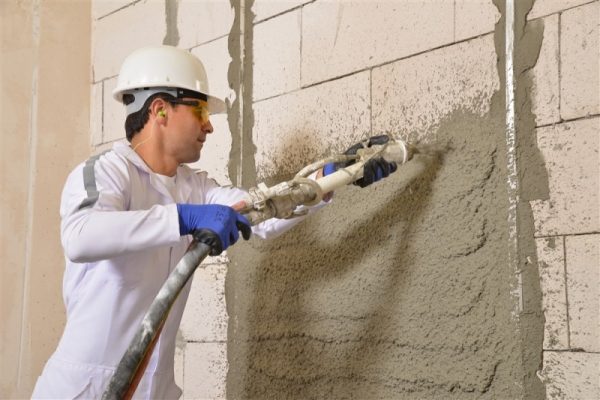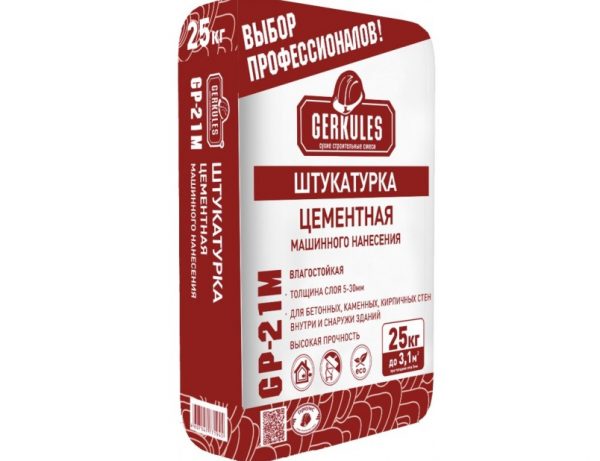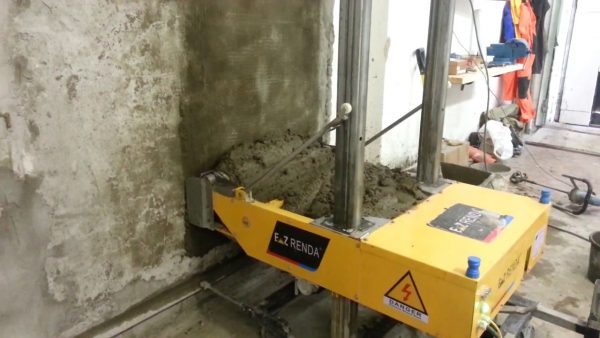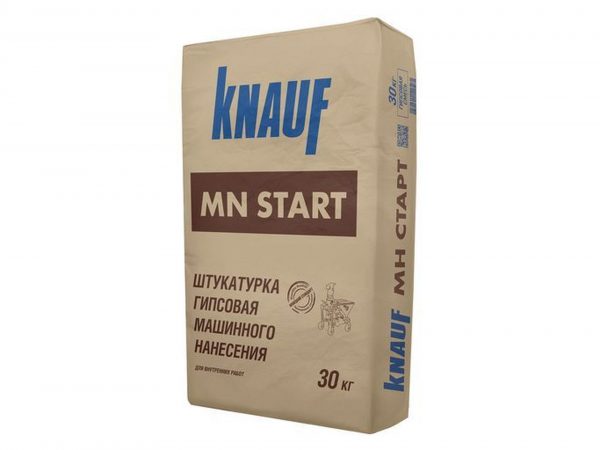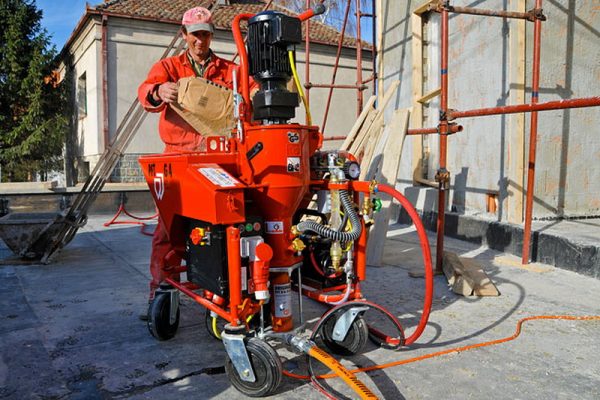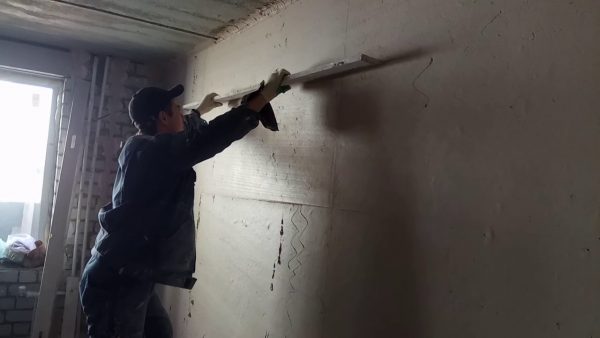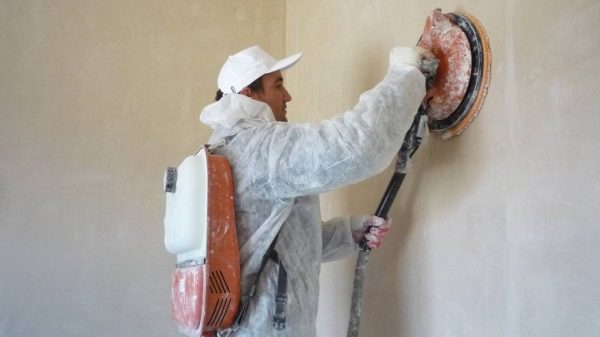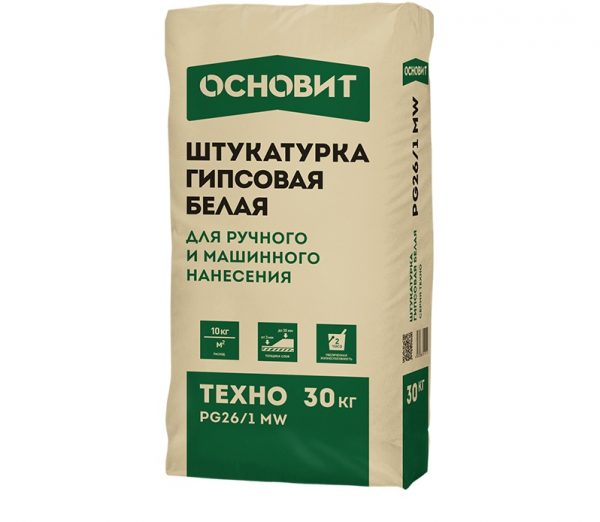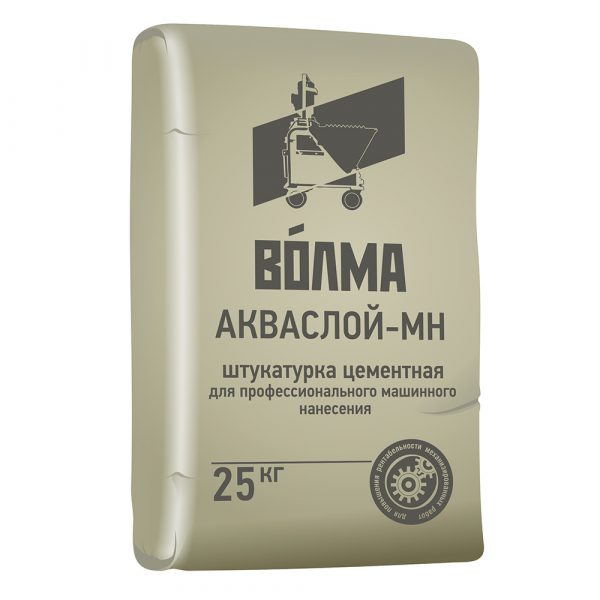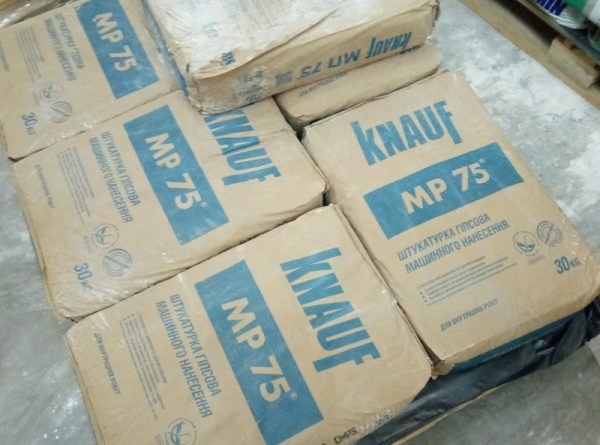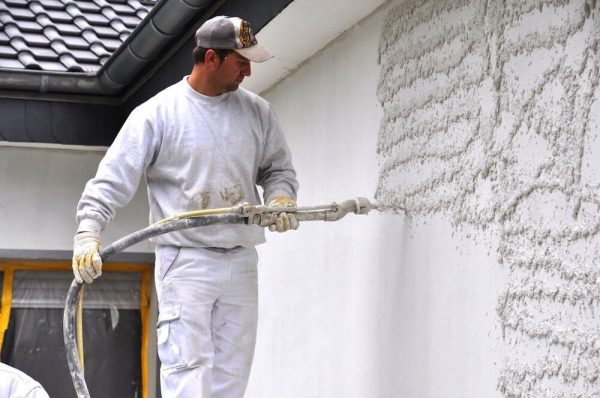Plastering plays a crucial role in wall cladding. Thanks to this process, the surfaces become smooth, suitable for finishing. In addition, heat and noise insulation are significantly improved, which improves the quality of life in houses or apartments.
- Mechanized plastering - what is it
- Features and specifics of the method
- Types of jobs
- Internal work
- Facing Facade Coating
- Dry mix application
- Surface treatment with ready-made solutions
- Equipment and tools
- Hopper Pneumatic Shovel
- Air gun
- Plastering machines and stations
- Plasterer robot
- Plastering and grouting devices
- Mortar for plastering
- Cement-sand compositions
- Gypsum compounds
- Plaster selection
- Surface preparation
- Equipment setup
- Stages of plastering
- Plastering
- Surface alignment
- Solution cutting
- Surface alignment
- Advantages and disadvantages of the mechanized method
- Which plastering is better - manual or mechanized
- Which method is cheaper
- Manufacturers of equipment and their products
- Mechanized application plaster
- "Prospectors"
- "Found"
- Volma
- Knauf

Since plastering is the most time-consuming and long stage of facing work, the issue of optimizing its performance is very relevant. Mechanized plastering involves applying the mortar using special devices that greatly simplify the actions of the master.
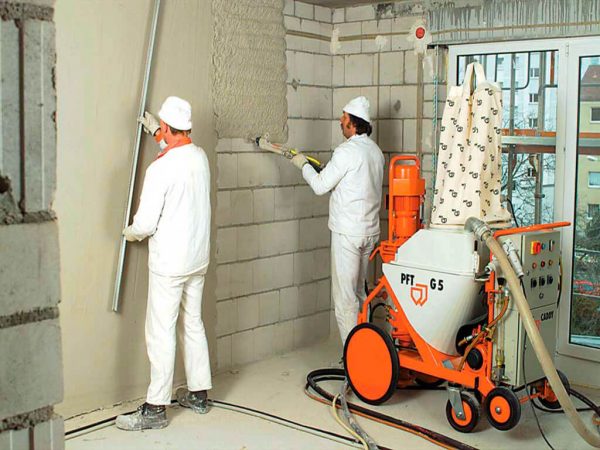
Mechanized plastering - what is it
By mechanized plastering is understood the process of surface finishing, during which the walls are plastered by machine. To implement this method, special equipment is used to partially or completely abandon manual labor. As a result, all stages proceed several times faster, and the quality of the cladding is an order of magnitude higher.
Machine plastering is a rather complicated process. Its implementation requires the availability of equipment, possession of information on its management and certain skills. Without a professional approach and with the wrong choice of tools, the result is unlikely to be positive. For independent manipulation, you need to undergo training and practice in practice.
to contents ↑Features and specifics of the method
There are various technologies for mechanized application of plaster, which differ in such indicators:
- degree of mechanization;
- principle of operation;
- method of mixing plaster;
- control the amount of water.
During the manual application of building mixtures, the master himself exerts pressure on the work surface, which ensures proper adhesion of the mortar with the base. With a machine-based plastering technique, the composition is already supplied under pressure, due to which it reliably adheres to the base. Due to the replacement of manual labor by machine, all stages of work are greatly simplified.
Mechanical plaster is used to align any vertical and horizontal surfaces - internal walls, ceilings, facades. For its implementation, building mixtures are used, adapted by consistency and composition. Without careful control of the proportions of the components, proper mixing and preparation, the plaster will not lie properly on the surface, and expensive equipment can be damaged.
to contents ↑Types of jobs
Machine plaster can be used everywhere, there are practically no restrictions on the areas of economic use. There are only recommendations on the seasonality of work. So, in winter time it is not necessary to plaster facades and other external surfaces, since they must have a temperature of +20 degrees and above. Otherwise, the finished layer will quickly crack.
Internal work
For the decoration of walls inside houses, apartments, and other heated rooms, all types of mortars can be used, although gypsum which is easy to apply and require a smaller layer thickness is more preferable. It is only important to remember that cleaning equipment from gypsum mixtures should be done in a short time, because after hardening it will be difficult to remove gypsum.
When performing outdoor work, it is important to prepare the surface in a quality manner - remove large defects, apply soil. Immediately before plastering, the walls are moistened with water and only then they begin to spray the composition. To reliably hold an impressive layer of cement plasters, a mounting grid is pre-mounted. Reinforcing material is also used on monolithic walls, which are too smooth and do not give the necessary adhesion to the solution.
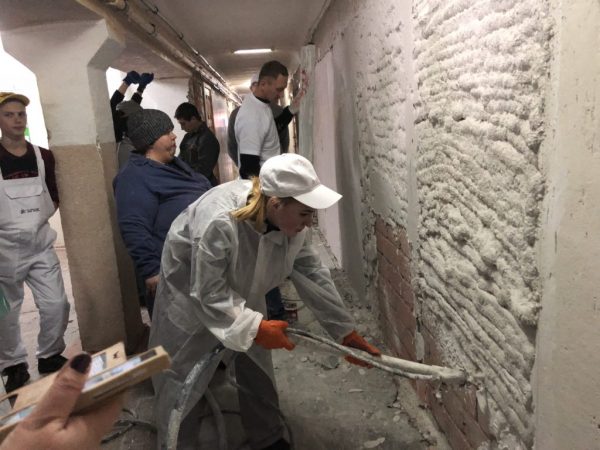
Facing Facade Coating
Work with external surfaces is carried out in the warm season, but not in direct sunlight and not in windy weather. Only at positive temperatures can you mix a high-quality mortar, perform the correct alignment of the walls. Usually, cement-sand mixtures with a rather large fraction are used for facade finishing, and the particle size should be consistent with the equipment settings. Especially carefully configure the machine when performing a layer of decorative plaster with pebbles or other inclusions.
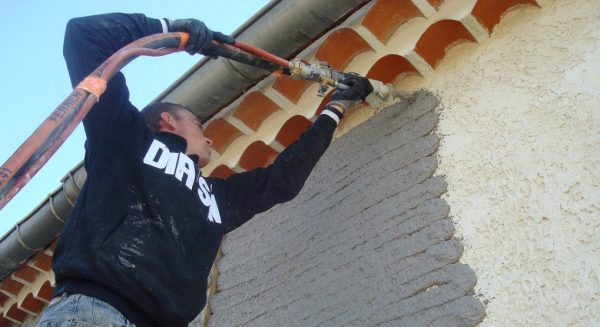
Dry mix application
Mechanized plastering can be carried out using pre-prepared mortars, as well as dry building mixtures, and in the second case, manual labor will be further reduced. It is important that the equipment is connected to a standard electrical outlet and has access to running water. The order of work will be as follows:
- pouring the dry mixture into a special container;
- connecting the machine to the network;
- adjusting the parameters of mixing the solution;
- preparation of plaster with a uniform consistency;
- supply of solution to the working surface under pressure.
Due to the perfectly even, airy structure of the plaster, the quality of the surface finish will be at a high level. After drying, such walls can be used for painting or gluing with thin wallpaper even without puttying.
to contents ↑Surface treatment with ready-made solutions
If the plaster is poured into the machine in a ready-made form, you won’t have to worry about water supply. To increase the time before hardening, the mixture is constantly mixed by the machine, as a result, the setting process is stretched. Ready-mixed mortars are best suited for plastering the ceiling, as well as for pouring screeds on the floor. It is only important to prepare the foundation in advance, to set the beacons on a level so that the result of the plastering work is excellent.
to contents ↑Equipment and tools
The specialized departments present a fairly large selection of tools and techniques that help mechanize the process of applying plaster. Among them, we can distinguish the simplest plaster buckets, pistols and even automated stations, and plasterers.
Hopper Pneumatic Shovel
A pneumatic shovel is a metal bucket with a volume of 3-5 l or more with holes for plaster below. On the contrary, there are air nozzles in an amount similar to the number of holes for supplying the stucco composition. The kit includes a pull-out handle with a handle that allows you to control the flow of the solution and adjust the working pressure (usually it is 4-6 atmospheres). Separately, such a device will need to buy a compressor with a capacity of 35 cubic meters. m / hour and hose.
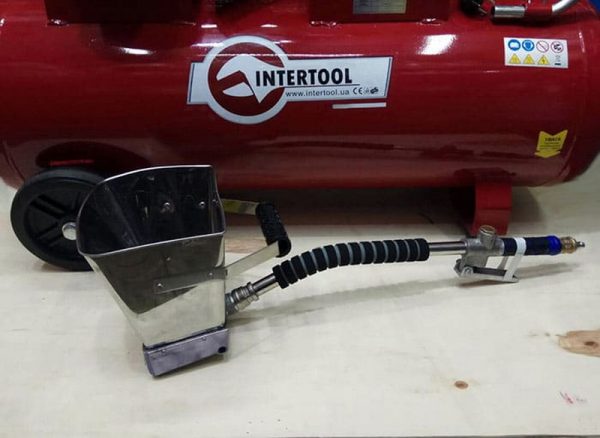
On sale there are two varieties of pneumatic shovels - ceiling and wall, differing in the shape of the bucket and the position of the handle. The process of working with any of the devices is not too complicated in comparison with plaster stations. The solution is kneaded in advance, scooped up by the hopper, installed at a small distance from the wall. Then, after turning on the machine, the plaster is sprayed onto the base by means of compressed air.
to contents ↑Air gun
Such a gun consists of a nozzle barrel on a handle with an attached container for plaster. The container can be made of metal or plastic and have a fairly large size (up to 9-10 l). Various nozzles are attached to the barrel, after which the trigger is pressed, and the plaster begins to flow onto the wall. After repeated pressing, the supply of the building mixture stops. Using a pneumatic gun, you can:
- rough finish;
- final application of the solution;
- textured spray.
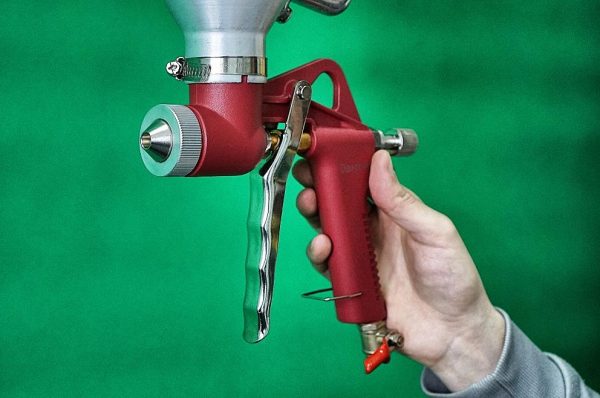
to contents ↑The cost of such devices is the lowest among devices for mechanization of labor of a plasterer. It is not difficult to use them, and yet, for starters, it is better to practice on small surfaces.
Plastering machines and stations
For significant amounts of work (on areas from 30-50 sq. M) plastering machines are an ideal solution. The cost of such devices is high, as well as rent, therefore, as a rule, they are owned by only professional construction crews. Plaster installations have a complex structure. Here are their main nodes:
- hopper for dry plaster mix;
- container for mixing and storage of the finished plaster;
- screw feed system;
- Control block;
- compressor.
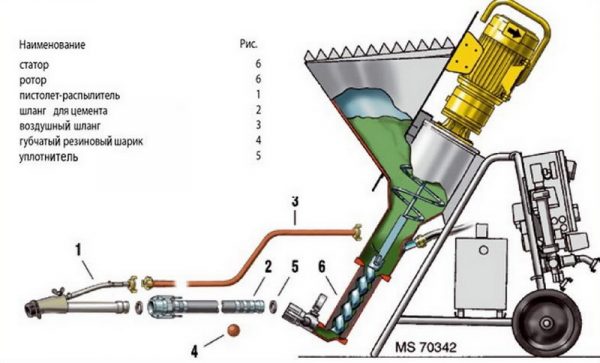
Screw type plastering stations are 100% automated. After mixing, the plaster under pressure passes into the sprayer, and then onto the surface to be treated. Pneumatic machines require pouring the finished building mixture, which is kneaded by the master in other equipment or manually.
Typically, domestic plastering stations are significant and have less functionality than imported ones. Nevertheless, most of these devices are suitable for working with any solutions, and foreign machines are more “picky". Some plastering stations are suitable even for spraying paint, lime, pouring screeds and self-leveling floors.
To work with small and medium in size and complexity devices, one operator is enough, for high-tech devices, service by a large number of specialists is required. Immediately after the completion of the plastering process, thoroughly rinse the containers, hoses, or turn on special cleaning modes.
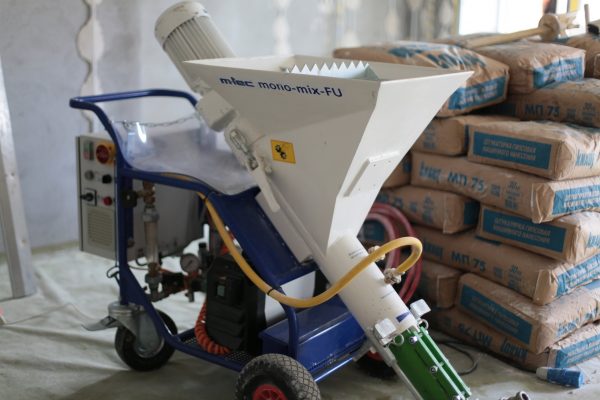
Plasterer robot
This is a type of plaster station, which allows you to apply the mortar on a smooth vertical base. The central part of the device moves along the guides attached to the floor and ceiling.
The building mix is mixed separately, even before being fed into the device, so you can use ordinary plasters and prepare them with a mixer. Most often, robot plasterer is used to decorate buildings no more than 7 meters high. Also, it is not suitable for working with flights of stairs, facades, uneven bases and ceilings.
to contents ↑Plastering and grouting devices
Disk plastering and trowelling installations allow you to level already finished walls, and the plastering process can even be done manually. The foam nozzle or chipboard in them is connected by a flexible shaft with an electric drive - a rotary engine with a small voltage (42 V) and an average current frequency (200 Hz). There is no risk of electric shock to the operator even when working with wet substrates. In single-disc trowels, the nozzle rotates in one direction. Double disc devices have two circles that can rotate in opposite directions.
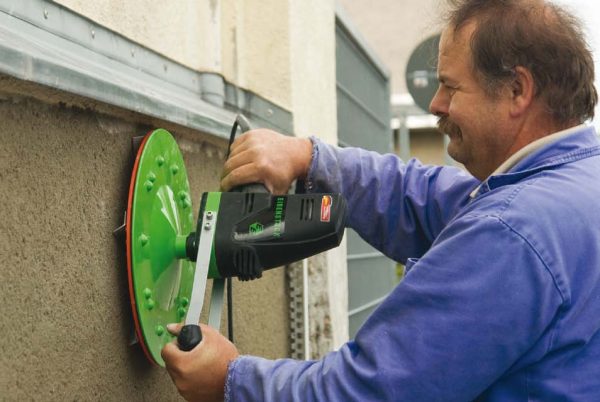
Mortar for plastering
For mechanized plastering, two types of mixtures are used - based on cement and gypsum.
Cement-sand compositions
Stucco with the addition of sand and cement is considered the most popular, especially for facade work and wet rooms. It easily tolerates contact with water, temperature extremes, is very durable and does not require frequent repeated repairs. Cement plasters boast high adhesion to various types of substrates, and standard measures are enough to prepare for work. Among the advantages, it is worth mentioning the cheapness of cement-sand plasters, because all their components are inexpensive.
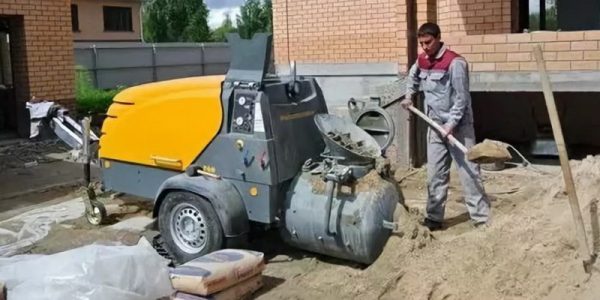
Among the disadvantages of such solutions are:
- unsuitability for plastic, wood, paint;
- significant weight of the plaster layer;
- the need for finishing (puttying);
- long drying time.
Gypsum compounds
Gypsum-based plasters are environmentally friendly, safe, lightweight, so the finished layer does not make the wall too heavy. They can be applied to any surface, and in most cases without reinforcement. Among other advantages of gypsum plasters, you can specify:
- lack of shrinkage, deformation, cracking after drying;
- increase of heat and noise insulation of the building;
- maintaining an optimal indoor microclimate;
- incombustibility, fire safety;
- excellent aesthetic qualities, perfect whiteness and evenness.
to contents ↑The cost of gypsum mortars is an order of magnitude higher than the price of cement-sand plasters. However, due to the low consumption, the total repair costs will be approximately the same. Gypsum plasters are not used in wet rooms and for outdoor use - because of the high porosity, they are saturated with water and fall off.
Plaster selection
First you need to determine the type of building mixture, because some installations involve working with ready-made compounds, others are capable of mixing the mortar themselves. When selecting the composition, the type of surface is taken into account: some plasters are considered universal, others, due to the presence of special modifiers, are more suitable for a particular material - concrete, brick, cellular concrete, foam blocks, etc.
When buying, you need to pay attention to the drying speed of the solution (it is also regulated by adding various substances), the degree of plasticity, strength. Stucco for outdoor use must be frost-resistant and withstand many cycles of freezing and thawing. If it is not planned to carry out finishing puttying, it is worth choosing gypsum plaster for work, but not for wet rooms.
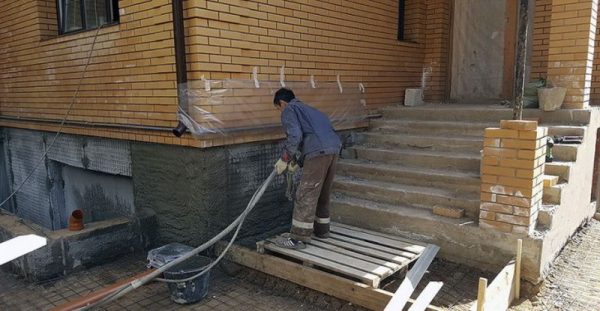
Surface preparation
Before starting mechanized plastering, it is important to carefully prepare all work surfaces:
- remove the old finish, which does not fasten on the wall, clean off the paint and the influx of plaster, wash off the lime;
- clean the walls of dirt and dust, which is especially true for outdoor foundations;
- as much as possible to clear out cavities, crumbling areas, reinforce with fiberglass mesh, seal up with cement plaster;
- treat metal elements with an anticorrosive composition;
- to fill the cracks and also seal with plaster;
- dedust the base by treating the soil with deep penetration of 1-3 layers (depending on the degree of porosity);
- if necessary, distribute special plaster profiles in the corners.
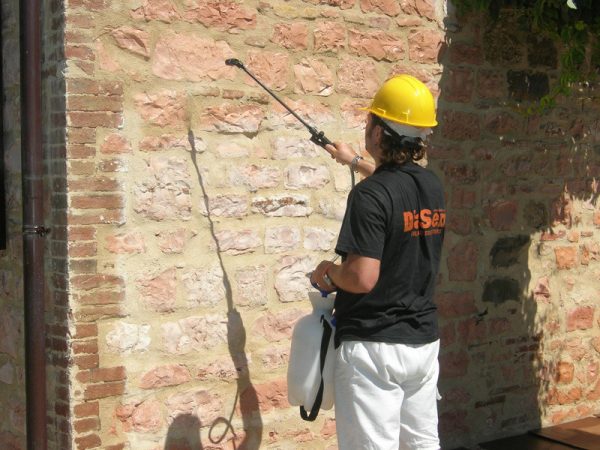
to contents ↑It happens that the outer surfaces greatly absorb moisture. In this case, priming with “concrete contact” will help, as well as preliminary wetting the walls, applying a thin layer of the mortar, drying it and further standard plastering.
Equipment setup
Before work, the readiness of the plaster devices for work is assessed. Usually, adjustment and adjustment are carried out directly at the place of decoration of the premises or facades. Check the car for compliance with safety regulations, make a test connection to the power grid, water source (fixed network, barrel, etc.).
Be sure to assess the density of the finished solution or accurately measure the desired proportions of the dry mixture and water. Also, the necessary parameters are tuned if the need for this is noted in the manufacturer's instructions.
to contents ↑Stages of plastering
The use of beacons will facilitate the application of plaster, will allow faster and better alignment of the walls. To establish the guides, carefully measure the base, find its most convex section, which will be the top point for applying the solution. After fixing the beacons, they begin to plaster and mash the walls. If work is carried out indoors, the occurrence of drafts is completely eliminated.
to contents ↑Plastering
First, the plaster installation is connected to the network, plaster powder is poured into it or the finished composition is poured. After they begin processing corners, joints of structures, and only then fill the main area. The nozzle of the device is kept at a distance of 15-30 cm (depending on the type of device), making sure that the plaster is sprayed strictly perpendicularly. Each new strip of solution should slightly overlap the previous one, but not higher than that noted by beacons. The greater the speed of the nozzle, the thinner the plaster layer.
to contents ↑
Surface alignment
The applied layer of plaster is aligned with the rule, unless, of course, work is carried out using a robot plaster. Also for this purpose they use smoothing machines, spatulas of large size. Lighthouses are cleaned or left inside (according to the selected technology). If it turns out that in some areas the plaster layer is too thin, “build up” it by hand and level it again. This stage of work is important to carry out immediately after applying the plaster, while it retains its fluidity.
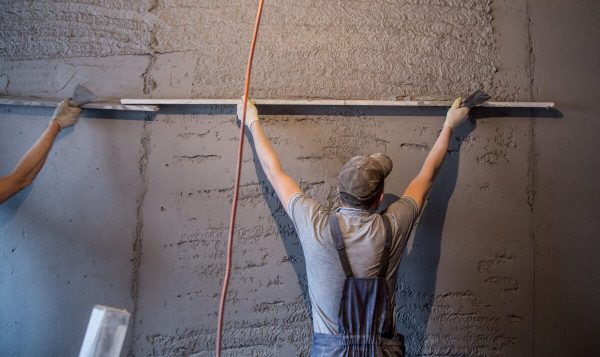
Solution cutting
After 20 minutes after leveling, the solution is trimmed with a cutter (trapezoidal rule), which will help to finally form the finish. First, they put the tool to the surface, drag it a little, as if cutting a thin outer layer. Make sure that the main layer does not drag along. Otherwise, they wait a little more time and repeat the manipulations. On a flat plane, it is permissible to leave fluctuations of not more than 2 mm for every 2 linear meters.
Surface alignment
After another 20-30 minutes, they begin to mash the base (you can start this stage after 2-3 hours, but only after preliminary spraying the wall with water). For this purpose, use graters, ironers, trowels. If the surface is being prepared for painting, after 6 hours after mashing, glossing is done - re-ironing with a wet tool.
to contents ↑Advantages and disadvantages of the mechanized method
The method of applying plaster using special equipment has its pros and cons. Here are its main advantages:
- High speed. Plastering of any surfaces is an order of magnitude faster than when manually applying a building mixture. Depending on the type of plaster, acceleration occurs 4-7 times, and there is no hard physical work.
- Strengthened adhesion.The release of the solution under pressure, which is the same throughout the entire working process, helps to improve the adhesion to the substrate. To achieve a similar effect with manual application, you need a lot of time and physical effort.
- Excellent quality. Mixing of the mortar in the plastering plants is carried out continuously. This helps to make the mixture homogeneous, with a smooth texture, so the dried layer dries evenly, does not crack, does not warp. Ready plaster is monolithic, without seams and ugly joints.
- Significant area. Using the mechanized method, you can immediately process the whole room without interruptions, which also reduces the risk of cracks and speeds up the repair time as a whole.
- Material saving. Some equipment can reduce the consumption of stucco in comparison with manual application. This is achieved by optimizing the viscosity of the solution and preventing its deterioration, withdrawal into mining, beating off the wall.
- Universality of equipment. Many types of plastering stations make it possible not only to apply plaster, but also to pour cement-sand screeds on the floor.
There are also disadvantages to mechanized plastering. So, the equipment for work is quite expensive, so the independent purchase of high-tech stations and robots is not advisable. Nevertheless, simple devices such as hopper buckets are much cheaper, and every master can afford to purchase them. To work with machine installations, often two people are needed, so you will have to invite an assistant.
Electrical installations are volatile, and at remote sites, in new homes where there is still no electricity, you will have to connect a diesel generator. In addition, for the use of sophisticated equipment, one must gain experience in its operation, cleaning, and maintenance. It will not work to apply the plaster in the evening or at night if there are neighbors nearby: usually plastering machines make quite a lot of noise.
to contents ↑Which plastering is better - manual or mechanized
Each technique has its own advantages and disadvantages, and the choice of a particular method should be made individually, depending on needs and capabilities. To make the right decision, you should familiarize yourself with the following conclusions:
- For the price, some plasters for stations and pneumatic shovels are cheaper than similar formulations for manual application. But in this case we are talking about gypsum solutions that contain additional improvers and modifiers. If you prepare the composition for application with a spatula yourself, mixing cement, sand, water, then the costs will be much lower than when buying a dry mixture in packages.
- With mechanized wall decoration, 2-3 kg less mortar is spent per square meter of area than with manual plastering. This advantage is lost only by replacing the more expensive mixture with a cement, made by yourself.
- With strict adherence to the technology and sufficient professionalism, it is possible to achieve no less high quality manual finishes than with mechanized plastering. To prevent the finished layer from cracking, you can use fiberglass, and the problem will be solved.
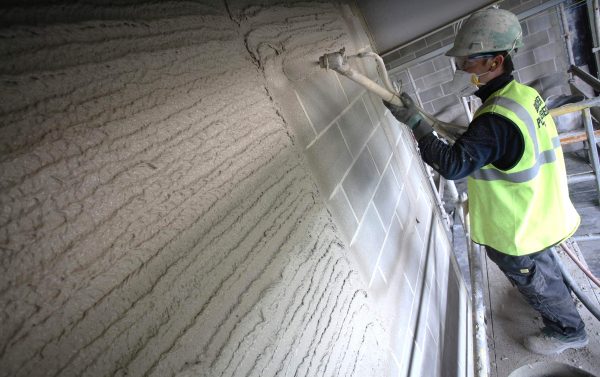
Which method is cheaper
The cost of plastering, performed by mechanized means, is from 220 rubles / sq. m and above. Hand stucco usually has a higher price - 250-300 rubles per 1 sq. Km. m of the first layer and from 550 rubles for 3 layers. But in practice, the price of wall decoration using special equipment may be more than the specified.
For example, with a total area of less than 2000 square meters. m it is growing, because it is more convenient for masters to work with large volumes. Time for installation of beacons, surface preparation will also be paid extra. Slopes can be plastered only by hand, and for this you will have to pay the craftsmen separately. Also often in the price are laid:
- time to move, equipment delivery costs;
- time to prepare the device and wash it after work;
- the cost of installing plaster corners.
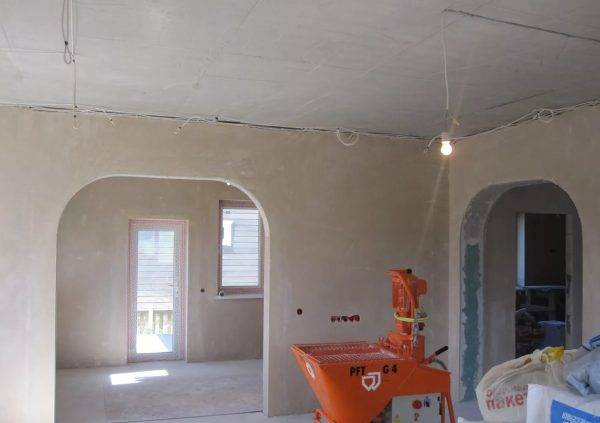
to contents ↑Also, the owner should calculate the cost of electricity, which are quite significant when using powerful plastering installations. As a result, the price of conventional and mechanized plaster may be approximately the same.
Manufacturers of equipment and their products
The most popular are plaster stations and PFT buckets from Knauf (Germany), which are characterized by excellent quality. For example, the PFT G4 380 model sprays 6-65 liters of plaster per minute, has the ability to feed up to 50 meters (vertically - up to 30 meters), works with a pressure of up to 30 bar.
The device of the PFT Monojet brand has less impressive characteristics, but it costs less: productivity - 15-35 liters / minute, pressure - up to 15 bar, flow - up to 26 meters. All equipment works from standard networks, but there are also multi-voltage devices (220V / 380V). Price - up to 250-300 thousand rubles.
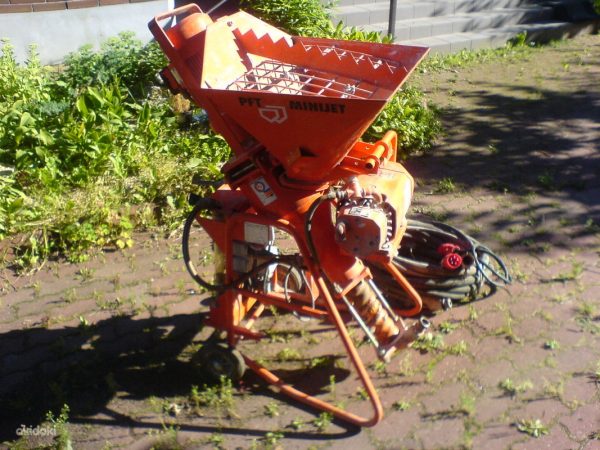
Other well-known manufacturers of plastering equipment are:
- Putzmeister;
- NOVO;
- "Typhoon";
- "Meteor";
- "Century";
- "Hermes".
Of the domestic devices for applying plaster, it is worth highlighting Afalina stations, which are also used for filling floors. For example, the Afalina ShM-30 machine has high functionality, independently mixes the plaster in a special container, and the proportions of the components are strictly programmed. The device is equipped with different nozzles, has a high performance, in a short time it plaster covers a fairly large area of walls, floor or ceiling. The only minus of the machine is its large dimensions, which makes servicing it a little more difficult than foreign counterparts.
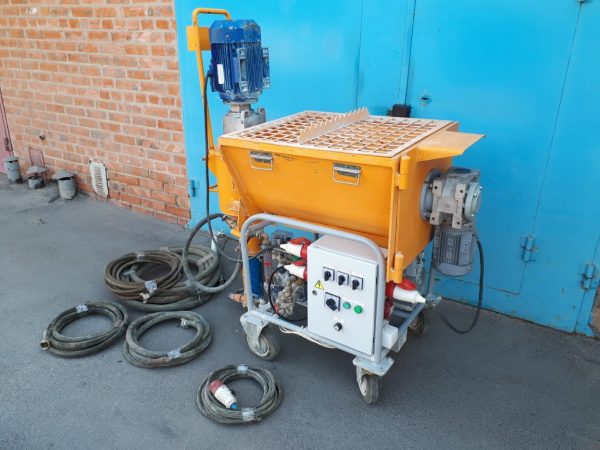
Mechanized application plaster
Among the assortment of goods for performing plastering work, you need to look for those that are suitable for mechanized supply, as always indicated by the manufacturer. There are no specialized formulations that would be intended exclusively for this method of application - each of them is also suitable for manual use.
"Prospectors"
The company offers a variety of mixtures that are well suited for mechanized plastering. They will not spoil expensive equipment, do not clog its important components and parts. For sale there are gypsum, cement plasters of this brand, as well as special cement-sand compositions for outdoor work with special additives.
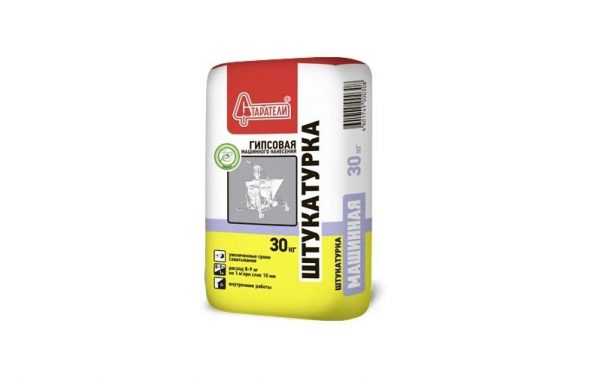
"Found"
Under the brand name "Founder" universal plasters are produced, which are suitable for manual and mechanized application. The manufacturer also produces separate compositions for each plaster layer (for spraying, sealing cracks and dents, thin-layer processing and for facades) in gray and white.
to contents ↑Volma
This company was one of the first in Russia to produce mixtures suitable for machine application. Now in the assortment there are various materials for string, beacon, beaconless applications. It is possible to choose plaster with the required setting time, including with increased (60 minutes).Also, the materials differ in the fraction of particles, while their maximum size is 1.25 mm.
to contents ↑Knauf
Under this German brand, a huge number of various building mixtures for manual and machine plastering and filling are produced. Plasters suitable for hardware use are marked MP or MN. For optimal results, it is recommended to use brand plasters in conjunction with PFT machines.
Mechanization of the plastering process provides a number of advantages, significantly reducing the complexity and improving the quality of the result. Professionals believe that the use of modern units is 100% justified by the aesthetics of the finish and the ability to do the job in the optimal time.

